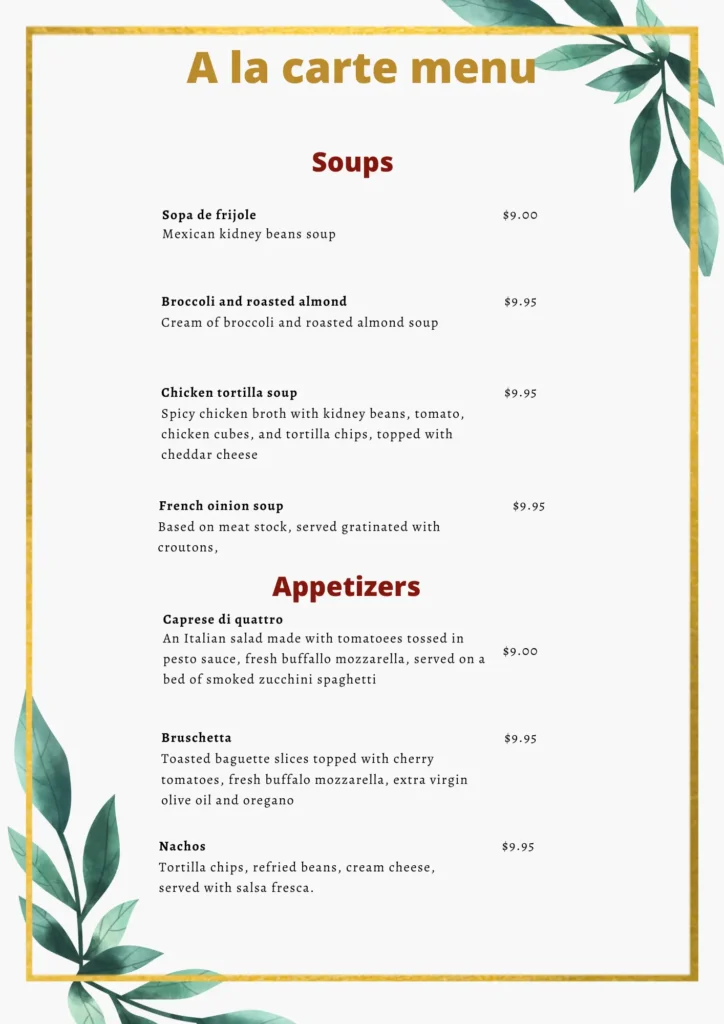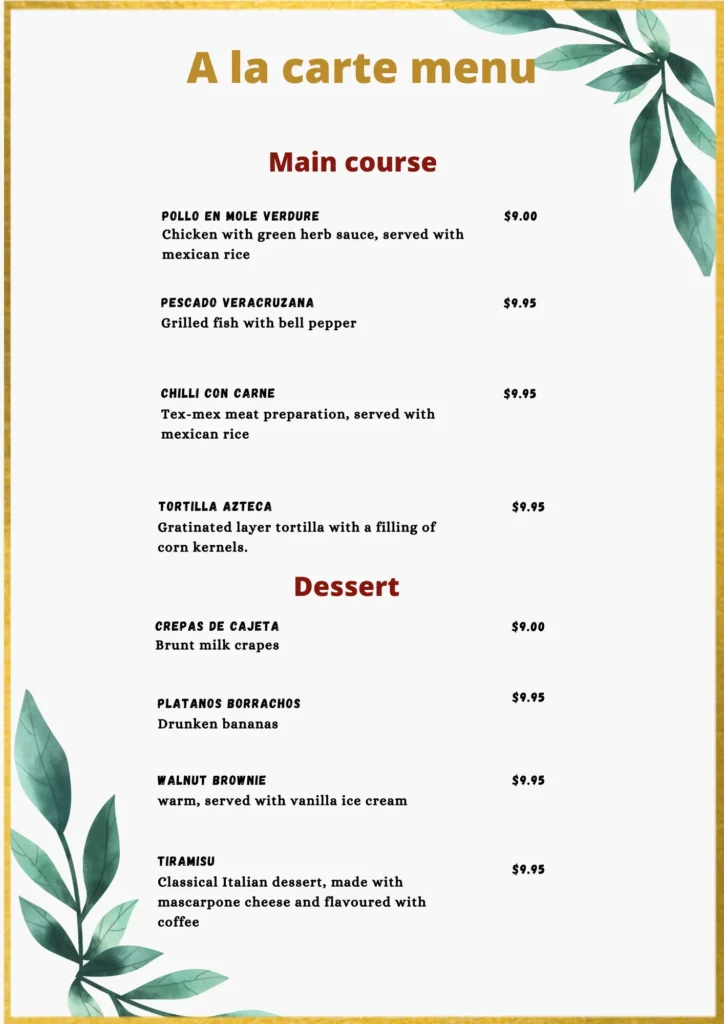The à la carte menu is a popular restaurant menu format that allows the customer to choose individual dishes, each with its own price, rather than being limited to a fixed set of courses. This customizable dining style is widely used in fine-dining restaurants, casual eateries, and hospitality services for its flexibility and guest-focused approach in restaurant service.
What is an À la Carte Menu?
The term “à la carte” is derived from the French language, meaning “according to the menu.” In the context of dining, it refers to a menu style where each dish is listed and priced individually, allowing customers to pick and pay for only what they want.
Unlike a Table d’hôte menu (a fixed-price, multi-course meal), an à la carte menu offers complete flexibility, giving diners the freedom to create a personalised meal based on their tastes and budget. Whether it’s just a starter and dessert or a full-course experience, the choice lies entirely with the guest.
🔊 How to Pronounce “À la Carte”:
The correct pronunciation is ah-lah-kahrt, reflecting its elegant French origin and the refined nature of the dining experience it represents.
Difference Between À la Carte and Table d’hôte Menu
- À la Carte: The main difference between an à la carte menu and a table d’hôte menu lies in the way dishes are offered and priced. An à la carte menu allows customers to choose each dish individually, with every item priced separately. This means diners can fully customise their meal, selecting only what they want to eat and paying only for those items. It’s a flexible and personalised dining experience commonly found in fine dining restaurants, cafés, and hotel room service.
- Table d’hôte: On the other hand, a table d’hôte menu provides a set number of courses, such as a starter, main course, and dessert, for one fixed price. The choices are usually limited, and the meal follows a structured sequence. This type of menu is often used in banquets, formal dining events, or traditional restaurants where a streamlined and efficient dining experience is preferred.
In short, à la carte gives more freedom and choice, while table d’hôte offers a complete meal at a set price with limited options.
Whether you’re planning your own menu or simply looking to enhance your dining knowledge, this guide offers a clear and comprehensive overview of à la carte menus.
Characteristics of an À la Carte Menu
Time-Intensive Preparation: Since each dish is made to order, preparation and serving time may take longer compared to buffet-style or set menus.
Individual Pricing: Each menu item has a distinct price, allowing diners to know exactly what they are paying for each dish.
Extensive Choices: À la carte menus feature a wide variety of options, including appetisers, main courses, sides, and desserts, giving diners the freedom to choose based on their preferences.
Customizable Meals: Diners can mix and match different dishes, creating a personalised dining experience that suits their taste.
Focus on Quality: Every dish is prepared fresh to order, ensuring higher quality and attention to detail in both flavour and presentation.
Diverse Culinary Styles: The menu can accommodate various cuisines and dietary preferences, such as vegan, gluten-free, gourmet, or even comfort food.
Elegant Presentation: Dishes are often plated with precision, enhancing the visual appeal and reflecting the restaurant’s commitment to excellence.
Sample of an À La Carte Menu
À La Carte menu featuring a selection of soups and starters.

Sample of an À La Carte Menu – Main Courses and Desserts
Here is another example of a premium À La Carte menu, focusing on main courses and desserts. This menu demonstrates how restaurants create a diverse range of offerings to delight their guests, with an emphasis on fine dining presentation and flexibility.

🔗 Ritz-Carlton Dubai – À la Carte All-Day Dining Menu
Explore an elegant à la carte menu from Ritz-Carlton Dubai, featuring Middle Eastern and international favourites with individually priced dishes.
👉 View Menu (PDF)
🔗 Ritz-Carlton Boston – Artisan Dinner À la Carte Menu
Discover a refined dinner selection from Ritz-Carlton Boston’s Artisan Bistro, offering modern American cuisine with à la carte flexibility.
👉 View Menu (PDF)
Examples of À la Carte Dishes
Breakfast:
- Omelettes: Choose from various fillings like cheese, mushrooms, spinach, or ham.
- Pancakes: Served with toppings such as fresh berries, syrup, whipped cream, or chocolate chips.
- Fresh Fruit Platters: A selection of seasonal fruits like melons, berries, and citrus.
Lunch:
- Grilled Chicken Caesar Salad: Crisp romaine lettuce, grilled chicken, croutons, and Caesar dressing.
- Pasta Carbonara: Spaghetti with creamy sauce, pancetta, eggs, and Parmesan.
- Gourmet Burgers: Customizable with toppings like cheese, bacon, avocado, and a variety of sauces.
Dinner:
- Filet Mignon: A tender cut of beef, often served with a choice of sauces (béarnaise, peppercorn, or garlic butter).
- Seafood Paella: A flavorful Spanish dish with a mix of shrimp, clams, mussels, and saffron rice.
- Vegetarian Risotto: Creamy risotto with seasonal vegetables like mushrooms, peas, and asparagus.
Desserts:
- Crème Brûlée: A classic French dessert with a crispy caramelised top and creamy custard base.
- Molten Chocolate Cake: Warm chocolate cake with a gooey centre, often served with vanilla ice cream.
- Seasonal Fruit Tarts: A delicate pastry filled with creamy custard and topped with fresh fruits.
Beverages:
- Speciality Coffees: Espresso, cappuccino, or latte, with optional syrups or flavoured milk.
- Freshly Squeezed Juices: Orange, grapefruit, or a mixed fruit blend.
- Craft Cocktails: Custom cocktails like a mojito, margarita, or an old-fashioned.
À la Carte Table Setup
The à la carte table setup is designed to enhance the personalised dining experience, where each dish is served individually and with great attention to detail. This setup differs from other dining styles like buffet or family-style setups due to its focus on formality, elegance, and individualised service.
Unlike a buffet or family-style meal, where guests serve themselves or share communal dishes, à la carte dining requires a more refined and organised approach. Each guest orders their own selection from the menu, and the table must be set to facilitate this individualised experience.
Key differences include:
- Precise Table Layout: In à la carte, the table is set with specific plates, glassware, and utensils for each course, ensuring that the presentation matches the sophistication of the menu. In contrast, buffet and family-style setups may use fewer plates or a more casual arrangement.
- Glassware Arrangement: The wine glasses in à la carte setups are arranged in order of use, reflecting the finer dining experience. In buffet or family-style settings, glassware might not be as formally arranged, since self-service is more common.
- Plated Service: In à la carte, dishes are plated individually and served by staff directly to each diner, ensuring freshness and attention to detail. This contrasts with buffet or family-style setups, where food is typically served in large portions for guests to help themselves.
- Napkin and Condiments: The careful placement of napkins and condiments in an à la carte setup emphasises formality, as opposed to the more casual and less structured approach in buffet or family dining.
The focus in à la carte dining is on offering a tailored, high-quality experience, with the setup designed to reflect the personalised service that comes with ordering individual dishes. This level of attention contrasts with more casual dining experiences, where efficiency and bulk service are prioritised.
Also read: 17 Course French Classical Menu: Examples & Description
Advantages of an À la Carte Menu
- Personalised experience – Diners choose exactly what they want.
- Increased revenue – Each dish is priced separately.
- Creative freedom for chefs – Allows for innovative and seasonal dishes.
- Premium ingredients – Focus on quality over quantity.
- Stronger customer loyalty – Guests appreciate customisation.
- Flexibility in menu updates – Easy to add or remove items.
- Showcase signature dishes – Helps build brand identity.
- Better portion control – Tailored to pricing and demand.
Disadvantages of an À la Carte Menu
- More complex operations – Custom orders increase kitchen pressure.
- Slower service times – Each dish is made fresh to order.
- Higher food waste risk – A Variety of ingredients may go unused.
- Staff training required – Servers need in-depth menu knowledge.
- Inventory management is harder – More ingredients to track.
- Decision fatigue for guests – Too many options can overwhelm.
- Higher expectations – Guests may expect lower prices or faster service.
- Labour-intensive – Requires more staff for preparation and service.
Also Read:
This article was written by Saswata Banerjee, the creator of Food and Beverage Service Knowledge, based on 8+ years of experience in the hospitality industry.


